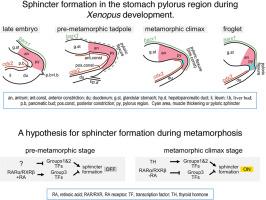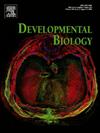Histological and gene-expression analyses of pyloric sphincter formation during stomach metamorphosis in Xenopus laevis
IF 2.1
3区 生物学
Q2 DEVELOPMENTAL BIOLOGY
引用次数: 0
Abstract
During anuran metamorphosis from herbivorous tadpoles to carnivorous frogs, the gastrointestinal (GI) tract undergoes drastic remodeling, such as the formation of the stomach-intestine boundary and the development of the pyloric sphincter at the posterior end of the stomach. However, the morphogenetic process and molecular mechanisms of how the pyloric sphincter is formed during metamorphosis, instead of during embryogenesis as in amniotes, are largely uninvestigated. Using the African clawed frog Xenopus laevis, we histologically examined the development of the pylorus region from embryonic to froglet stages and performed spatiotemporal gene expression analyses. We found that the pyloric sphincter is formed at a flexure within the pyloric region during metamorphic climax, and that the pyloric and duodenal epithelia, which are morphologically indistinguishable before sphincter formation, become clearly demarcated by the sphincter at the end of metamorphosis. Consistent with these morphological changes, expression domains of a stomach marker barx1 and an intestine marker cdx2 overlapped until late metamorphic climax, but became separated after metamorphosis. Despite the absence of the sphincter before metamorphosis, various genes crucial for sphincter formation in amniotes were already expressed in the pylorus region of Xenopus embryos. RNA-sequencing analysis at pre-metamorphic and metamorphic-climax stages suggest unappreciated roles of genes, such as those for retinoic acid signaling and various transcription factors, in suppressing or promoting sphincter formation. These data provide histological and molecular insights into the heterochrony of the pyloric sphincter formation in amniotes and anurans.

爪蟾胃变态过程中幽门括约肌形成的组织学和基因表达分析
在有尾目动物从草食性蝌蚪到肉食性蛙类的变态过程中,胃肠道经历了剧烈的重塑,例如胃肠边界的形成和胃后端的幽门括约肌的发育。然而,幽门括约肌是如何在变态过程中形成的,而不是像羊膜动物那样在胚胎发育过程中形成的,其形态发生过程和分子机制在很大程度上尚未得到研究。我们利用非洲爪蛙,从组织学角度研究了幽门区域从胚胎期到仔蛙期的发育过程,并进行了时空基因表达分析。我们发现,幽门括约肌是在变态高潮期幽门区域内的弯曲处形成的,在括约肌形成之前,幽门上皮和十二指肠上皮在形态上无法区分,而在变态末期,幽门上皮和十二指肠上皮被括约肌清晰地划分开来。与这些形态变化相一致的是,胃标记物 barx1 和肠标记物 cdx2 的表达域在变态后期重叠,但在变态后则分开。尽管在变态前没有括约肌,但对羊膜动物括约肌形成至关重要的各种基因已经在爪蟾胚胎的幽门区域表达。在变态前和变态顶峰阶段的 RNA 序列分析表明,视黄酸信号转导基因和各种转录因子等基因在抑制或促进括约肌形成方面的作用尚未得到重视。这些数据为羊膜动物和有尾动物幽门括约肌形成的异时性提供了组织学和分子学方面的见解。
本文章由计算机程序翻译,如有差异,请以英文原文为准。
求助全文
约1分钟内获得全文
求助全文
来源期刊

Developmental biology
生物-发育生物学
CiteScore
5.30
自引率
3.70%
发文量
182
审稿时长
1.5 months
期刊介绍:
Developmental Biology (DB) publishes original research on mechanisms of development, differentiation, and growth in animals and plants at the molecular, cellular, genetic and evolutionary levels. Areas of particular emphasis include transcriptional control mechanisms, embryonic patterning, cell-cell interactions, growth factors and signal transduction, and regulatory hierarchies in developing plants and animals.
 求助内容:
求助内容: 应助结果提醒方式:
应助结果提醒方式:


